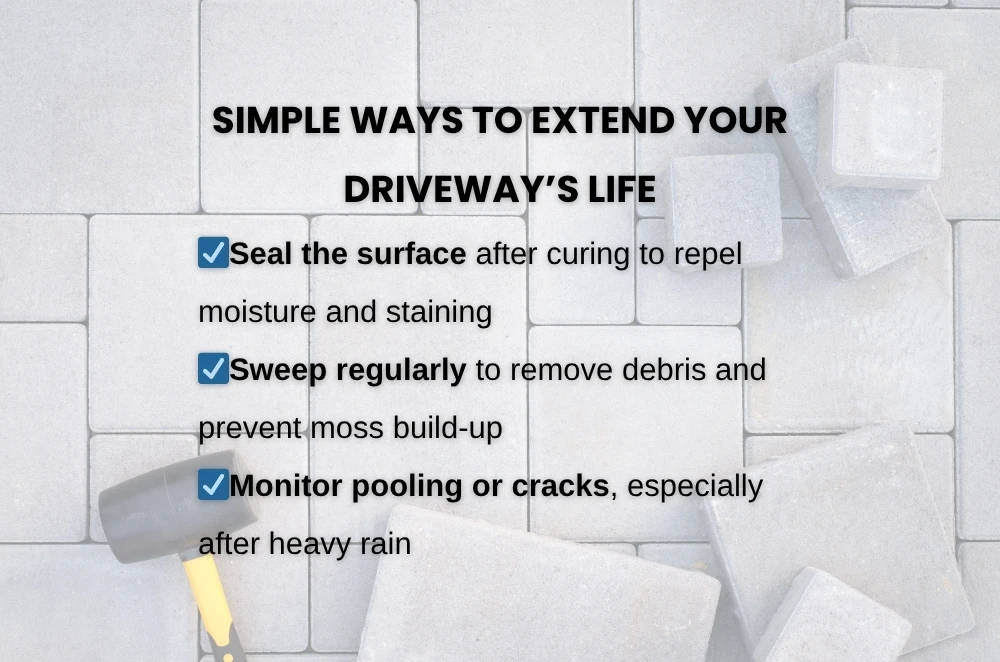Winter can be a make-or-break season for outdoor surfaces, especially driveways. Between frost-thaw cycles, cold rain, and heavier wear from vehicles, even minor cracks or dips can turn into major eyesores. If you've been debating an upgrade, this might be the best time to book driveway paving services that know how to tackle cold-season conditions. Contrary to common belief, winter isn’t just doable for driveway work — it’s often ideal.
Here’s how to make sure your project lasts, looks sharp, and stands up to Aussie winters.
Why winter is a better time than you'd think
Most homeowners assume driveway work should wait for spring or summer. But in many parts of Australia, especially where winters are dry and moderate, the cooler season offers some real advantages:
- Less competition for bookings with paving contractors
- Lower heat stress on materials during curing and setting
- Potential cost savings thanks to off-season labour and materials
In our case, we received a quote in June, started work in July, and completed the entire process by mid-August, with no delays, no puddles, and no unexpected price hikes. It also meant we were ready for spring with a clean, finished look out front.
Know what winter weather means for your area
Winter conditions vary widely across the country, and understanding what you’re working with can help tailor your paving plan:
- Victoria and Tasmania: Frequent rain and softer ground
- South Australia: Cool, dry winters are ideal for hardscaping
- NSW and coastal QLD: Mild, with occasional wet periods
- Inland regions: Risk of frost and morning freezes
Regardless of your location, the two main enemies of paving are excess water and ground movement, both of which winter can trigger. Choosing the right surface type and base is crucial. For best results, it’s wise to refer to reliable guides on construction systems that are tailored to Australian conditions, ensuring your paving can withstand seasonal challenges.
Best materials to use in winter
Not all driveway materials perform equally when cold and wet weather hits. Some soak up water and crack, while others resist damage and settle beautifully.
Winter-resilient driveway materials include:
- Permeable pavers – Allow water to drain, preventing pooling and erosion
- Concrete pavers – Hard-wearing and frost-tolerant
- Natural stone – Like bluestone or granite, excellent for both performance and looks
Materials to avoid in wet, cold conditions:
- Clay pavers – Absorb water and may shift or crack
- Loose gravel – Easily displaced and hard to maintain during heavy rainfall
When we replaced our old gravel driveway, we chose interlocking concrete pavers. The drainage was far superior, and even after several back-to-back rain days, there wasn’t a single puddle.
Don’t skimp on preparation
If there’s one place you shouldn’t cut corners — no matter the season — it’s site prep. But it’s especially important in winter when damp soil can spell long-term trouble.
Key prep steps for winter paving:
- Excavate and remove organic material like roots, mulch, or soft soil
- Install a geo-fabric membrane to keep the base stable in wet areas
- Compact in layers using crushed rock for a solid, frost-resistant base
- Ensure a good drainage slope to direct runoff away from the driveway
Improper base compaction or ignoring water flow will cause settling, cracking, or worse — frost heave. That’s why winter jobs need precision.
If you’re unsure how to maintain your outdoor surfaces through the colder months, NSW’s official site on external maintenance offers solid tips that apply to driveways too.
Give your driveway the best chance with seasonal care
Once your driveway is paved, the work isn’t over. Winter is tough on outdoor surfaces, so maintenance matters.
One winter, we ignored a small dip near the front gate — just a tiny bit of water gathering after storms. By spring, that spot had turned into a slick algae patch that made our postman nearly fall. Lesson learned: deal with minor issues early.
Tie your driveway into your whole outdoor space
A well-paved driveway should feel like part of a broader outdoor plan, not an afterthought. Especially in winter, when many gardens look sparse, your driveway can provide structure and appeal.
Try pairing your paving with:
- Defined edging for tidy transitions to lawn or beds
- Low-profile lighting for safety and style on shorter days
- Garden walls or screens to create separation and function
- Matching materials in paths or patios for visual cohesion
If you’re juggling multiple winter garden projects, don’t overlook the role of consistent outdoor upkeep. This is where thoughtful landscape maintenance tips can tie everything together and prevent your hard work from going to waste.
Add value with smart upgrades
Beyond function, driveways offer an opportunity to lift the look and value of your home, especially for properties set back from the street or in areas with tight front yard space.
Popular upgrade ideas:
- Dual-tone paver designs to add texture and depth
- Inlaid drain channels to manage water flow without ruining aesthetics
- Recessed lighting built into paving edges for visibility and curb appeal
- Feature entrances with plant borders or stone inlays
A note on smart timing: Think long-term
There’s no denying that winter paving requires forethought. But the benefits — from better scheduling to avoiding peak-season rush — often outweigh the challenges. My advice? Don’t wait for spring. We paved in July, timed our landscaping in August, and by the first warm days of September, the whole outdoor area was ready to use — no tradies, no noise, no delays. The project was done, sealed, and admired before most people had even started thinking about their driveways. We also picked up some great driveway paving tips for Aussies, which made a real difference in how well everything held up.



